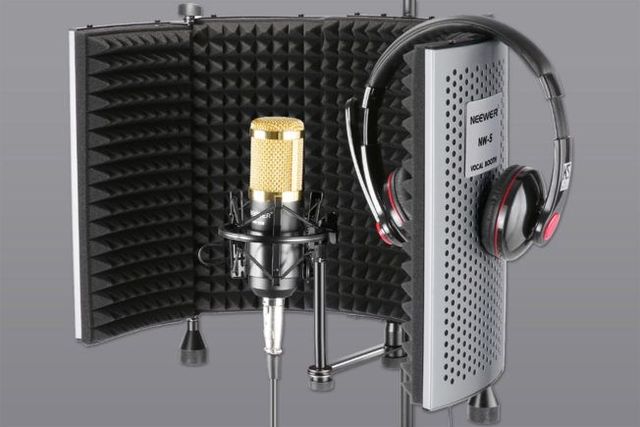Don't know if you would be interested, but I use something similar to this for my vocal mic (mounts on a mic stand and then extension from that mount area is where the mic is mounted):
That said, the SM7B is a tough fit in many of these type units because of its depth (and these units from different manufacturers accommodate different depths based on length of side panels and mic mounting arms), but I have done it and it does give the mic some isolation from sounds coming from the back. BTW, never hang your headphones anywhere near a mic like they do in this pic, it can create feedback loops in some circumstances that could damage your cans!
Certainly those small gobos can help isolate a mic, especially when there's bleed from other sources like in a live band recording (they work on guitar amps, too), or you have loud computer fans, disc drives, etc.
Because a ribbon mic is figure-of-eight and picks up a lot of sound from the rear, that's another good use for it, where needed.
However...one has to remember they're designed to solve problems in rooms, and not all rooms have those problems. There are audio tradeoffs that need to be considered.
If you're cutting vocal overdubs, or have the vocalist in a recording booth, and set the mic to a cardioid pattern (the most often used for vocals). the only reason to use a gobo is if the room has serious problems with reflections and noise. Many do have problems, especially very small or very live rooms.
But most vocals are cut with cardioid mics that are designed to reject reflections behind the mic (i.e. the wall facing the singer), and many rooms just don't have bad sound. I've never even needed one in an overdub context with a ribbon mic here.
The other thing to keep in mind is that if the bad reflections are coming from the
rear of the room behind the singer, a gobo in
front of the mic can't solve that problem. I've also experienced rooms where the worst reflections were bouncing between floor and ceiling and making the audio sound very boxy, like being in a locker. Again, can't be solved with a vertical gobo, you'd need the gobo above the singer and the mic.
In most contexts, a gobo like the one pictured isn't going to do very much with a cardioid setting on the mic, except perhaps deaden off-axis side reflections. Trouble is, those reflections often make a recording sound more natural. Artificial reverb alone sounds...artificial. A little room sound is usually not a bad thing - unless it's a terrible sounding room (for example, an empty room - i.e., without absorptive furniture - that's got a hard floor and lots of glass).
I have a gobo for solving such problems that's large enough for guitar amps, but it also works for vocals. I have it 'just in case'. But I don't recall needing or using it in the last 6-7 years.
Except where there's serious noise, a very bad room, or lots of band bleed, a gobo is often a solution in search of a problem. So before investing in something like that, I'd suggest recording in the room and listening for reflections that sound phasey or otherwise make the audio sound bad.
If unsure of where the bad reflections are, move the mic around and record in different parts of the room. Try recording near furnishings, or with a closet door open. In other words...experiment a little.
My two cents' worth of advice is don't fix what isn't broken. I'm not knocking those, sometimes you need one. Just figure out whether it's a necessity before unleashing the wallet!



